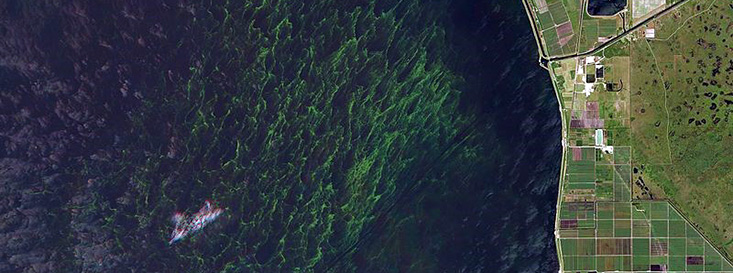Written By: Carrie Pinkard, Science Journalism Intern for USFCMS
Lisa Krimsky recently spoke at USF College of Marine Science about Florida’s largest lake – Lake Okeechobee. Krimsky is a is a faculty member with the University of Florida IFAS Extension and the Florida Sea Grant Program. She discussed the lake’s past, as well as what’s currently happening and what changes we might expect in the future. In case you missed her talk, here are five main takeaways.
1. Lake Okeechobee Has a Long History of Flooding
In the early 1900’s several plans were enacted to try to drain water out of Lake Okeechobee to the coasts. From 1905-1926 there was The Everglades Drainage District project. This project connected the Caloosahatchee river and the St Lucie River to Lake Okeechobee and allowed for a navigable waterway across the state.
Then came the Herbert Hoover Dyke, completed in 1937 that resulted in flood control improvements. It turns out these attempts to displace excess water were no match for hurricane season. Back to back hurricanes in 1947 left 90% of Southeast Florida underwater. At a loss for what to do next, Florida turned to the federal government for help. Congress then responded with the Central and South Florida Project to help with flood control, water supply, and wildlife protection.
“It created levees and flood control protection across Southeast Florida, and that it what allowed the populations in Miami-Dade county, Broward county, and Palm Beach county to exist today,” Krimsky said of the project.
2. Lake Okeechobee Should be Called Reservoir Okeechobee
Because of the manmade structures we put in place to control water flow, Lake Okeechobee no longer drains as a normal lake. Before we installed the dam, water would naturally flow south in a very slow trickle down the state of Florida. Instead, now the lake acts as a reservoir. The 750-square-mile lake has to take on water from the 5,000-square-mile Kissimmee basin.
The inflow capacity to the lake far exceeds the outflow. The main sources of outflow the lake has are the Caloosahatchee river and St Lucie estuaries. The lake’s water levels are artificially managed by the US Army Corps of engineers, who have control over three dams surrounding Lake Okeechobee.
“They have a map that tells them when they should be lowering lake levels for safety and when they should be keeping lake levels high for water supply,” Krimsky said.
3. Water Management Has Impacted Lake Okeechobee’s Quality
As water was transported into Lake Okeechobee from surrounding areas, so were pollutants and harmful nutrients. Historically, water containing phosphorus from cattle farms flowed into the lake from the north while water containing nitrogen from sugar farming was pumped into the lake from the south. These nutrients have built up over the years and now exist in harmful levels.
The total phosphorus load within the lake is around 500 metric tons. Ideally it would be around 100 metric tons.
“Even though we’re seeing less phosphorus coming in from the inflow, we have this status where the internal loads are pretty much equal to the external loads, to the extent that it’s estimated that you can have no loads of nutrients going into lake Okeechobee and it would be more than 50 years until the internal loads would actually disappear,” Krimsky said.
4. Florida’s Weather is Exasperating Lake Okeechobee’s Problems
In Florida we go from extreme drought to massive rainfalls. When there is little rain, the nutrients in the water are highly concentrated. When the rain comes, it loosens the nutrients and sends them on a journey with the water.
In 2017 for instance, rain came down in record amounts in June. This oversaturated the earth and released most of the phosphorus and nitrogen. Then Hurricane Irma came in September, and since surrounding areas couldn’t possibly absorb anymore water, all of that water and more than 1,000 tons of phosphorous came pouring into Lake Okeechobee.
Due to the high levels of nutrients, Microcystis algae is forming in Lake Okeechobee. When the water levels get too high, the water is sent through the St Lucie estuaries and Calossahatchee river, this means the algae is sent to these areas as well.
“When you’re talking about algae blooms, it’s all about the weather. Periods of extreme drought and extreme rain make the situation worse. We’re going to be seeing more of that pattern in the future,” Krimsky said.
5. We Need to Keep Finding New Ways to Deal With Florida’s Water Problem
Florida is surrounded by water and is constantly getting pummeled by huge storms. Therefore, Floridian’s war against water will never be over. According to Krimsky, It’s important we keep moving forward with the Comprehensive Everglades Restoration Plan. The plan includes many features including water storage, stormwater treatments, and seepage management.
We need to find alternate ways to store all the water. One of the ways we’re doing this is through water farming, a program where the state pays farmers to use their unfarmed lands to store water. Another way is through aquifer storage. The good thing about aquifer storage is we are able to store water and also retrieve it when we need it.
“The state of Florida gets about 1,000 new people every day and with that is increased water demand. How do we manage excess water when we don’t need it with water shortages at time when we do need it?” Krimsky said.
